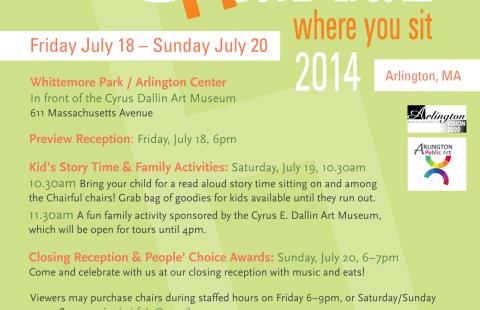What were the specific goals of this creative economy project? Describe the community development challenge or opportunity that your project was designed to address:
APA is a committee of the Town of Arlington, but we have no operating budget. We needed a way to raise money and bring awareness of the benefits of public art to a fairly conservative community. The specific goals are to create community, provide an unusual, accessible, participatory art event, and raise funds for Arlington Public Art.
If the goals change over time, please describe how:
The very first Chairful Where You Sit was a guerilla-type art event held for a full week on the Minuteman Bikeway that runs through Arlington. Very little publicity accompanied the exhibition, partly because we wanted to surprise people with an unexpected exhibition in an unusual place. That initial effort spawned 30 creatively-transformed chairs and raised $3000! The funds helped us to accomplish our first initiative of a digitally printed mesh vinyl banner, 25' x 80', that was hung on the side of the Arlington Boys and Girls Club. The subsequent Chairful events have been bigger but shorter in length, while attempting to engage more people and different segments of Arlington. Now the event is held in front of the Cyrus E. Dallin Art Museum in Arlington Center, a very appropriate site because Dallin not only lived in Arlington, but his public sculptures are famous in Boston.
Who was involved in this project and what did they do? (be sure to include the partners from outside of the creative sector and how local voices were included):
The project partners include the Arlington Board of Selectmen and the Cyrus E. Dallin Art Museum, as well as grant money from the Arlington Cultural Council. The Board of Selectmen grant us permission each year for the use of public space. When we moved the exhibit from the bikepath to the park in front of the Dallin Art Museum, we engaged the Dallin Art Museum. The museum is staffed by volunteers and they need attention and funds. Chairful Where You Sit has given them a more visible profile in Arlington. Last year we held a family read aloud hour in the exhibit to bring more young families and children to see the chairs. We also asked local businesses and restaurants to donate small prizes for our annual Peoples' Choice awards.
How does this project relate to a larger community development strategy?
Chairful Where You Sit has grown into a flagship,, much-anticipated annual event. Arlington residents resonated with the idea of rescuing chairs from the trash stream and reinventing them. The exhibit engages both professional artists and community members who love the idea and want to try it. In this way, we are making public art both accessible and fun. Purchasing an affordable and unique chair by a neighbor or friend has turned out to be an incredibly popular idea, and has allowed APA to raise enough funds to produce both an annual public art exhibit at a local park and a transformer box mural project for which artists are paid a stipend. We believe that the success of these Chairful events has put our group on the map and has opened up many peoples' eyes to the community-building and economic growth potential of placing art in the public realm.
What projects or places, if any, inspired your approach to this creative economy project?
Chairful Where You Sit was inspired by the temporary public art events I have seen in Somerville, MA and Stowe, VT's annual "Exposed" exhibition. I am also aware of other initiatives that are based on having artists paint the same type of chair, animal, or other mascot. Chairful is different in that it invites the public to be part of the exhibition and also to re-use a common and accessible object that might otherwise be thrown away.
